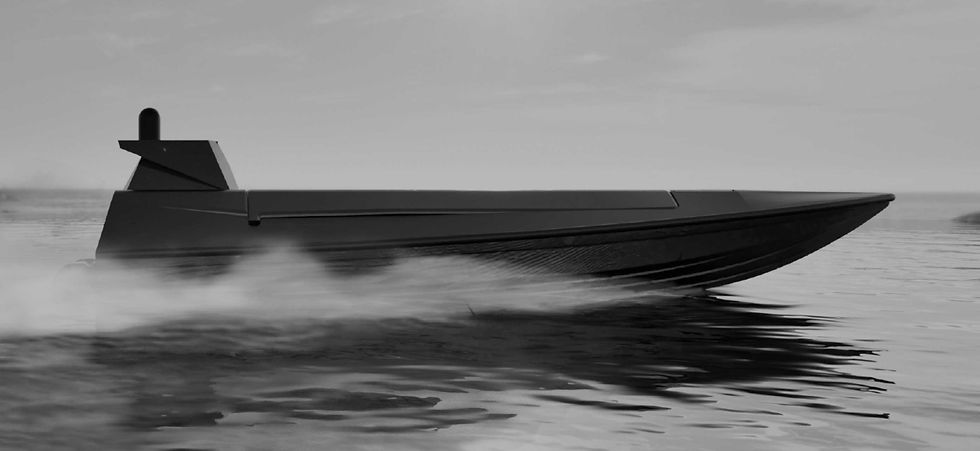
Title 01
Change the text and add your own content, including any information that is relevant to share. Then customize the font, size and scale to make it your own.

Title 02
Change the text and add your own content, including any information that is relevant to share. Then customize the font, size and scale to make it your own.

Title 03
Change the text and add your own content, including any information that is relevant to share. Then customize the font, size and scale to make it your own.

Sea
AI-driven autonomy is redefining naval defense, enabling vessels to perceive, decide, and act with unmatched precision in complex maritime environments.
State-of-the-Art
The current state of maritime defense technology reveals significant gaps:
Conventional Naval Forces - Most European navies rely on manned vessels with limited autonomous capabilities and minimal AI integration.
Limited Surveillance Capacity - Continuous monitoring of large sea areas and detection of underwater threats remains incomplete and personnel-intensive.
Minimal AI Integration - The use of artificial intelligence for navigation, domain analysis, and anomaly detection is still underdeveloped.
Active Sensor Dependency - Traditional maritime systems rely on active sonar, radar, and other emitting technologies that reveal position and intent.
Communication & Weather Constraints - Limited bandwidth, interference risks, and weather sensitivity restrict the reliability of remote maritime operations.

Challenges
Complex Maritime Navigation
Dynamic sea states, coastal environments, and congested waterways overwhelm conventional navigation systems.
Environmental Variability
Changing weather, sea conditions, and visibility create unpredictable operational environments.
Stealth Requirements
The need to operate without active emissions that could reveal position and intent will be crucial for survival.
Sensor Degradation
Salt spray, fog, and water reflections impair sensor performance and data quality.
Persistent Surveillance
The need to continuously monitor large sea areas requires long-duration autonomous operations.

Marinized Computing Platforms
Robust, saltwater-resistant computer systems for AI processing at sea.

Advanced Passive Sensors
High-resolution cameras, thermal imaging systems, passive acoustics, and passive RF detection will become indispensable.

Energy Autonomy
Long-lasting energy systems for extended missions without resupply.
Resource Requirements

the role of AI
Maritime Domain Analysis
AI must be able to interpret complex maritime environments, classify vessels, and detect anomalous behavior.
Autonomous Navigation
Systems must be able to navigate safely under various sea conditions and in coastal proximity.
Multi-Platform Coordination
AI must enable collaboration between surface, underwater, and aerial systems.
Certifiable Algorithms
AI systems must comply with maritime and military standards and function predictably.

Our AI Solution

1
Passive-Only Navigation - Our proprietary sensor fusion and maritime SLAM technology enables precise positioning and route planning in complex maritime environments without GPS dependency or active emissions.
2
Multi-Modal Passive Maritime Perception - Fusion of data from electro-optical, infrared, passive acoustic, passive RF detection, and other non-emitting sensors for comprehensive situational awareness under all conditions.
3
Edge-Optimized Processing - All computations are performed directly on the vessel's existing hardware, requiring no external infrastructure or data links for autonomous operation.
4
Maritime Domain Awareness - AI-driven analysis of complex maritime environments for vessel classification, behavior prediction, and anomaly detection without active sensing.
Emission-Free Maritime Intelligence
SPLEENLAB's VISIONAIRY® Defense Suite revolutionizes naval warfare through advanced passive autonomy:
Why Spleenlab is Different
Mission execution without active emissions—ideal for GPS-denied and stealth-critical environments.
Developed from the ground up to meet naval standards, with formal verification and full certification support.
Runs efficiently on existing onboard systems—no hardware upgrades needed. Compatible with USVs, AUVs, and hybrid platforms.
AI-driven perception enables persistent surveillance, vessel classification, and anomaly detection without active sensors.
Reduces operator workload by enabling the control of multiple autonomous systems simultaneously.

Resources
Solutions
Customers
Spleenlab GmbH is a highly specialized AI perception software company founded with the vision of redefining safety and artificial intelligence.
©
2025
Spleenlab GmbH | All Rights Reserved